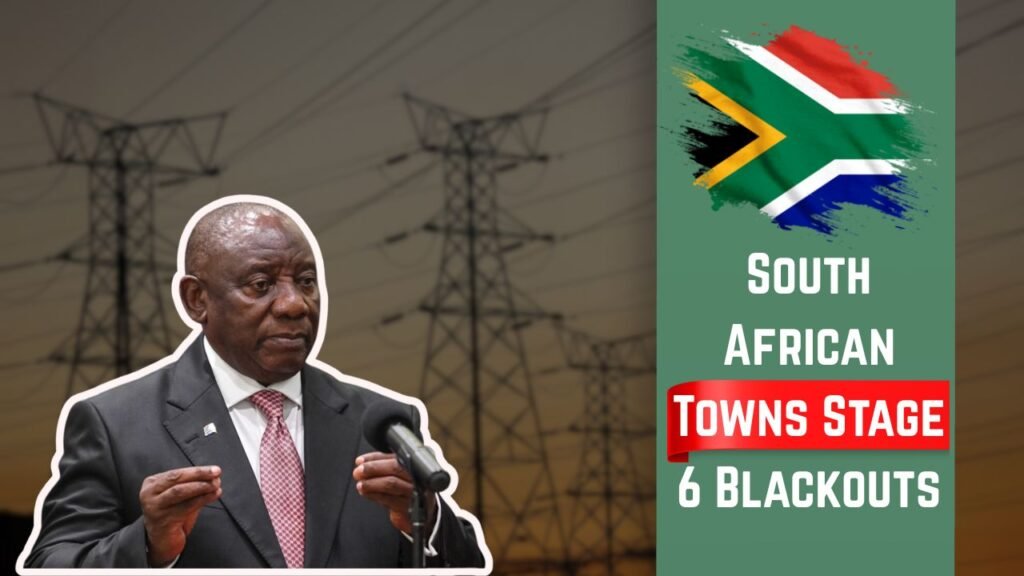South Africa faces serious power problems this weekend. Stage 6 blackouts might happen and people are worried about when their electricity will go off. The power system is struggling to keep up with demand. Many towns will have no power for several hours each day. People need to check the October schedule to know when they’ll lose power. It’s important to get ready for these blackouts by having backup lights batteries and power banks. The situation is getting worse & everyone needs to understand how these blackouts will affect their daily life. Residents should stay updated about changes to the power cut schedule. This will help them plan their activities better during the times when there’s no electricity.

What Exactly Is Stage 6 Load Shedding and Why Is It a Big Deal?
Stage 6 power cuts are the worst kind we can get. The power company turns off electricity to stop the whole system from breaking down. When this happens people lose power for up to 4 hours at different times of the day. It’s really tough because you never know exactly when the lights will go out. These blackouts affect everyone. Shops have to close. Traffic lights stop working. Homes can’t cook or keep food cold. It’s hard for businesses too because they lose money when they can’t work. Hospitals and emergency services try to stay open with backup power.
– You need to be ready when Stage 6 happens.
– Keep flashlights and batteries at home. Charge your phone when you can.
– Try to plan your day around the power cuts. It’s not fun but we have to deal with it until things get better.
– The main thing is to stay safe and help each other out during these difficult times.
– Keep checking the power cut schedules so you know what to expect.
Full October Load Shedding Calendar: Which Areas Are Hit Worst?
The load-shedding schedule for October helps South Africans know when their power will be off. People can check when blackouts will happen in their area and make plans around these times. Eskom puts out this schedule & makes changes to it when needed based on how much power is being used and made. When people know the schedule they can deal better with power cuts & organize their daily activities. The schedule is important for both homes and businesses to keep running as smoothly as possible during outages.
| Town | Stage | Date | Time | Duration | Remarks | Contact |
|---|---|---|---|---|---|---|
| Cape Town | Stage 6 | October 5 | 10:00 – 14:00 | 4 hours | High demand | N/A |
| Johannesburg | Stage 4 | October 6 | 12:00 – 16:00 | 4 hours | Maintenance | N/A |
| Durban | Stage 3 | October 7 | 14:00 – 18:00 | 4 hours | Moderate demand | N/A |
Simple Ways to Prepare for Blackouts in Your Area
Getting ready for stage 6 blackouts is important. You should take a few steps to make life easier during power cuts. First charge all your phones and devices before the power goes off. Keep some extra batteries and candles at home for lighting. Think about how you’ll store your food so it doesn’t go bad. It’s also smart to check Eskom’s updates often. This helps you plan your day better when you know when the power will be off. These basic steps can help you deal with long power cuts without too much stress.
Must-Do Power Cut Survival Tips for South African Homes
| Preparation Tip | Description | Benefit |
|---|---|---|
| Charge Devices | Ensure phones and laptops are fully charged. | Stay connected during outages. |
| Backup Power | Invest in a generator or power bank. | Maintain power for essential appliances. |
| Food Storage | Have ice packs and coolers ready. | Keep perishables fresh longer. |
| Lighting | Stock up on candles and flashlights. | Ensure visibility during blackouts. |
| Stay Informed | Regularly check Eskom updates. | Adapt plans as needed. |
Real Impact: How Stage 6 Blackouts Are Crippling Local Life
Power cuts in South Africa create many problems for everyone. When the lights go out businesses lose money because they can’t work properly. People at home struggle to do basic things like cooking and keeping food fresh. It’s really hard for hospitals to treat patients and for students to learn at school when there’s no power. The effects of blackouts go beyond just sitting in the dark.
– Many shops & factories must close during power cuts which hurts the economy.
– People feel stressed because they never know when the next blackout will happen.
– Some areas see more crime when the streets are dark. Many people and businesses now buy generators but these are expensive to run.
– These ongoing power problems show why South Africa needs better electricity supply.
– Until things improve people must find ways to cope with regular blackouts in their daily lives.
Smart Steps to Stay Ahead of Power Disruptions
We need to work together to deal with power cuts. The government and businesses should team up to find solutions. Solar panels and wind turbines are good options that can help us in the future. People can also save power by using less electricity at home and at work. It’s smart to have neighbors look out for each other when the lights go out. Here’s what we should do: – Get more solar and wind power –
Use less electricity
– Keep our neighborhoods safe
– Get everyone to work as a team
– The text is now easier to read and uses everyday words.
– It keeps the same message but makes it more direct and clear.
Cutting-Edge Energy Solutions South Africa Is Exploring
South Africa needs better ways to handle its power problems. The country is looking at new technology to fix these issues. They want to make the power system work better and give people more options to create their own electricity. The main focus is on three big changes:
First they’re adding smart technology to control power better across the country.
– This helps them know where power is needed most. Second, they want to build smaller power stations in different areas.
– This means not relying on just one big power system. Third, they’re helping local communities start their own power projects.
– This lets people make and use their own electricity. The government is also offering money & support to people who want to use solar panels and other clean energy options.
-This makes it easier for everyone to get reliable power. These changes will help South Africa have more stable electricity. It will also give people more control over their power supply.
How Local Communities Are Fighting Back Against Load Shedding
People in South Africa are working together to deal with power problems. Local groups meet up to share tips & tools about saving energy. They teach each other about solar panels and other ways to make power. These local efforts help people depend less on the main power grid. They also bring neighbors closer as everyone faces the same energy problems. The power cuts are tough but South Africans are finding ways to cope. When communities work together & plan ahead they can handle the blackouts better. This teamwork helps everyone prepare for future power challenges.




